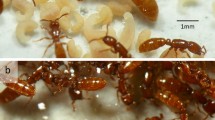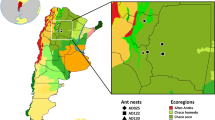Summary
The existence of a worker caste in Prorhinotermes inopinatus was determined with the help of biometrical analyses and morphological observations. No dichotomy between alate and worker lines was detected among the young larval instars. Mandible sclerotization and wear show that the larvae become active by the fourth instar in mature colonies, and by the third in incipient ones. Prothoracic finger-shaped expansions characterize the most dependent larval instars. The antennal structure is the best feature for distinguishing late instars. The developmental schema is very flexible: the late larvae of stages 5 to 8 (at least) can give rise to wing-padded nymphs, to the next larval instar, to presoldiers, or most likely to neotenic reproductives as well; the wing-padded individuals (nymphs) normally moult direct to alates, but they can also undergo a regression of their wing pads and revert to worker-like individuals or differentiate into soldiers or neotenics. Slight variations in alate size and antennal morphology result from their origin in different larval instars. Whole-colony censuses revealed that the major part of the colony's work force is composed of pseudergates, i.e. late larvae that do not follow the most direct pathway to the alate. The pseudergates of Prohinotermes do not constitute a distinct worker caste irreversibly diverted from the alate developmental pathway. For this reason the caste system of Prorhinotermes is analogous to that of the Kalotermitidae and Termopsidae and much more primitive than those of the other Rhinotermitidae so far studied, Reticulitermes, Schedorhinotermes and Coptotermes.
Similar content being viewed by others
References
Banks N, Snyder TE (1920) A revision of the Nearctic termites. US Natl Mus Bull 108:1–228
Bess HA (1970) Termites of Hawaii and the Oceanic Islands. In: Krishna K, Weesner FM (eds) Biology of termites, vol 2. Academic Press, New York, pp 449–476
Buchli HR (1950) Recherche sur la fondation et le développement des nouvelles colonies chez le termite lucifuge (Reticulitermes lucifugus Rossi). Physiol Comp Oecol 2:145–160
Buchli HR (1958) L'origine des castes et les potentialités ontogénétiques des termites européens du genre reticulitermes Holmgren. Ann Sci Nat Zool Biol Anim [11] 20:263–429
Bugnion E (1911) L'imago du Coptotermes flavus. Larves portant des rudiments d'ailes prothoraciques. Mem Soc Zool Fr 24:97–106
Darlington JPEC (1986) Seasonality in mature nests of the termite Macrotermes michaelseni in Kenya. Insectes Soc 33:168–189
Deligne J, Quennedey A, Blum MS (1981) The enemies and defense mechanisms of termites. In: Hermann HR (ed) Social insects, vol 2, Academic Press, New York, pp 1–76
Emerson AE (1955) Geographical origin and dispersions of termite genera. Fieldiana Zool 37:465–521
Gay FJ, Barrett RA (1983) The occurrence in Australia of Prorhinotermes inopinatus Silvestri (Isoptera: Rhinotermitidae). J Aust Ent Soc 22:75–77
Grassé P-P, Noirot C (1946) Le polymorphisme social du termite à cou jaune (Calotermes flavicollis F.). La production des soldats. C R Acad Sci Paris 223:929–931
Grassé P-P, Noirot C (1947) Le polymorphisme social du termite à cou jaune (Calotermes flavicollis F.). Les faux-ouvriers ou pseudergates et les mues régressives. C R Acad Sci Paris 224:219–221
Hare L (1934) Caste determination and differentiation with special reference to the genus Reticulitermes (Isoptera). J Morphol 56:267–293
Heath H (1927) Caste formation in the genus Termopsis. J Morphol Physiol 43:387–425
Hill GF (1942) Termites (Isoptera) from the Australian Region. CSIR, Melbourne, p 479
Imms AD (1919) On the structure and biology of Archotermopsis, together with descriptions of new species of intestinal Protozoa, and general observations on the Isoptera. Philos Trans R Soc London [B] 209:75–180
Kalshoven LGE (1930) De biologie van de djatitermiet (Kalotermes tectonae Damm.) in verband met zijn bestrijding. Meded Inst Plantenz 76:1–154
Luamba JLN (1980) Recherches sur le polymorphisme et aperçu sur l'influence de l'hormone juvénile sur le développement d'un termite, Hodotermes mossambicus (Isoptera, Hodotermitidae). Biol Ecol Medit 7:169–171
Lüscher M (1952) Untersuchungen über das individuelle Wachstum bei der Termite Kalotermes flavicollis Fabr. (Ein Beitrag zum Kastenbildungsproblem.) Biol Zentralbl 71:529–543
Luykx P (1986) Termite colony dynamics as revealed by the sex- and caste-ratios of whole colonies of Incisitermes schwartzi Banks (Isoptera: Kalotermitidae). Insectes Soc 33:221–248
Mednikova TK (1977) Caste differentiation in the termite Anacanthotermes ahngerianus Jacobson (Isoptera, Hodotermitidae). Proceeding of the VIIIth International Congress IUSSI, Wageningen, pp 118–120
Miller EM (1942) The problem of castes and caste differentiation in Prorhinotermes simplex (Hagen). Bull Univ Miami Med Jackson Mem 15:1–27
Myles TG (1987) Evidence of parental and/or sibling manipulation in three species of termites in Hawaii (Isoptera). Proc Hawaii Entomol Soc (in press)
Myles TG, Chang F (1984) The caste systems and caste mechanisms of Neotermes connexus (Isoptera: Kalotermitidae). Sociobiology 9:163–321
Noirot C (1955) Recherches sur le polymorphisme des termites superieurs (Termitidae). Ann Sci Nat Zool Biol Anim [11] 17:399–595
Noirot C (1969) Formation of castes in the higher termites. In: Krishna K, Weesner FM (eds) Biology of termites, vol 1. Academic Press, New York, pp 311–350
Noirot C (1982) La caste des ouvriers, élément majeur du succès évolutif des termites. Riv Biol 75:157–195
Noirot C (1985a) Pathways of caste development in the lower termites. In: Watson JAL, Okot-Kotber BM, Noirot C (eds) Caste differentiation in social insects. Pergamon Press, Oxford, pp 41–57
Noirot C (1985b) The caste system in higher termites. In: Watson JAL, Okot-Kotber BM, Noirot C (eds) Caste differentiation in social insects. Pergamon Press, Oxford, pp 75–86
Noirot C, Pasteels JM (1987) Ontogenetic development and evolution of the worker caste in termites. Experientia 43:851–860
Nutting WL (1969) Flight and colony foundation. In: Krishna K, Weesner FM (eds) Biology of termites, vol 1. Academic Press, New York, pp 233–282
Nutting WL (1970) Composition and size of some termite colonies in Arizona and Mexico. Ann Entomol Soc Am 63:1105–1110
Oster GF, Wilson EO (1978) Caste and ecology in the social insects. Princeton University Press, Princeton
Pickens AL (1934) The biology and economic significance of the western subterranean termite, Reticulitermes hesperus. In: Kofoid CA (ed) Termites and termite control, 2nd edn. University of California Press, Berkeley, pp 157–183
Prestwich GD (1983) Chemical systematics of termite exocrine secretions. Annu Rev Ecol Syst 14:287–311
Quennedey A, Deligne J (1975) L'arme frontale des soldats de termites: I. Rhinotermitidae. Insectes Soc 22:243–267
Renoux J (1976) Le polymorphisme de Schedorhinotermes lamanianus (Sjöstedt) (Isoptera-Rhinotermitidae). Essai d'interprétation. Insectes Soc 32:279–494
Roisin Y, Pasteels JM (1985) Imaginal polymorphism and polygyny in the Neo-Guinean termite Nasutitermes princeps (Desneux). Insectes Soc 32:140–157
Roisin Y, Pasteels JM (1986) Differentiation of worker-derived intercastes and precocious imagoes after queen removal in the Neo-Guinean termite Nasutitermes princeps (Desneux). J Morphol 189:281–293
Roisin Y, Pasteels JM (1987) Caste developmental potentialities in the termite Nasutitermes novarumhebridarum. Entomol Exp Appl 44:277–287
Roy-Noël J (1968) Etudes biométrique et morphologique du couvain de Coptotermes intermedius. Insectes Soc 15:389–394
Schedel A, Kaib M (1987) Polyethism during foraging in Schedorhinotermes lamanianus in unprotected areas: the role of exocrine glands. In: Eder J, Rembold H (eds) Chemistry and biology of social insects. Peperny, München, p 416
Sewell JJ, Watson JAL (1981) Developmental pathways in Australian species of Kalotermes Hagen (Isoptera). Sociobiology 6:243–323
Silvestri F (1909) Isoptera. In: Michaelsen W, Hartmeyer R (eds) Die Fauna Südwest-Australiens, vol 2. Fischer, Jena, pp 279–314
Snyder TE (1926) The biology of termite castes. Q Rev Biol 1:522–552
Springhetti A (1969) Il controllo sociale della differenziazione degli alati in Kalotermes flavicollis Fabr. (Isoptera). Ann Univ Ferrara (NS) Sez III Biol Anim 3:73–96
Stuart AM (1970) The role of chemicals in termite communication. In: Johnson JW Jr, Moulton DG, Turk A (eds) Advances in chemoreception, vol 1: Communication by chemical signals. Meredith, New York, pp 79–106
Thorne BL (1982) Polygyny in termites: multiple primary queens in colonies of Nasutitermes corniger (Motschulsky) (Isoptera, Termitidae). Insectes Soc 29:102–117
Traniello JFA (1981) Enemy deterrence in the recruitment strategy of a termite: soldier-organized foraging in Nasutitermes costalis. Proc Natl Acad Sci USA 78:1976–1979
Vrkoč J, Ubik K (1974) 1-Nitro-1-trans-pentadecane as the defensive compound of termites. Tetrahedron Lett 1974:1463–1464
Watson JAL, Sewell JJ (1981) The origin and evolution of caste systems in termites. Sociobiology 6:101–118
Watson JAL, Sewell JJ (1985) Caste development in Mastotermes and Kalotermes: which is primitive? In: Watson JAL, Okot-Kotber BM, Noirot C (eds) Caste differentiation in social insects. Pergamon Press, Oxford, pp 27–40
Watson JAL, Metcalf EC, Sewell JJ (1977) A re-examination of the development of castes in Mastotermes darwiniensis Froggatt (Isoptera). Aust J Zool 25:25–42
Zimmerman RB (1983) Sibling manipulation and indirect fitness in termites. Behav Ecol Sociobiol 12:143–145
Author information
Authors and Affiliations
Additional information
Contribution No. 139 from King Léopold III Biological Station, Laing Island, Papua New Guinea
Senior research assistant of the National Fund for Scientific Research, Belgium
Rights and permissions
About this article
Cite this article
Roisin, Y. Morphology, development and evolutionary significance of the working stages in the caste system of Prorhinotermes (Insecta, Isoptera). Zoomorphology 107, 339–347 (1988). https://doi.org/10.1007/BF00312217
Received:
Issue Date:
DOI: https://doi.org/10.1007/BF00312217




